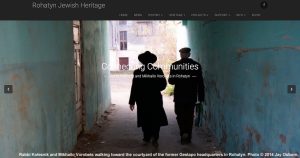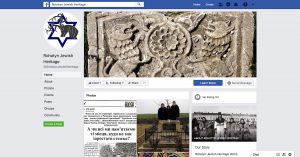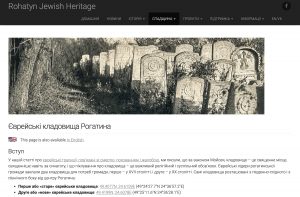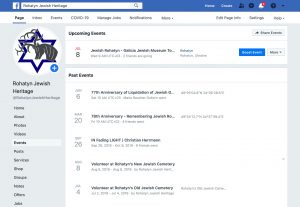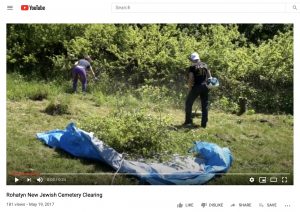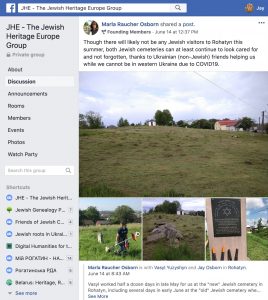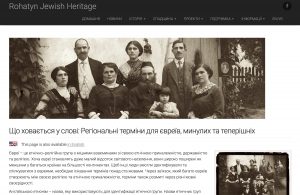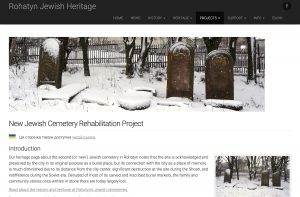![]() Ця сторінка також доступна українською.
Ця сторінка також доступна українською.
Introduction
This page summarizes and analyzes a project which describes and promotes the Jewish heritage of Rohatyn in the Rohatyn raion of the Ivano-Frankivsk oblast, in order to inform, to raise awareness, and to encourage engagement by others in the city, the region, and abroad, to support increased preservation of the sites and the memory of the lost Jewish community which formerly cared for those sites. This communication effort is not a standalone project focused on a single burial site; instead it is integrated into preservation plans and projects which support two Jewish cemeteries and two mass graves plus a handful of other Jewish heritage features in Rohatyn, and aims to attract and attach others to help reintegrate these places with heritage of the several cultures which once shared this historically diverse region.
This page is intended as a reference for similar projects now in the planning stages in western Ukraine or beyond. Following a brief summary of the site, the material below describes the project and reviews its effectiveness together with a listing of issues encountered, approximate project costs, and ongoing risks. Related projects both in western Ukraine and elsewhere in Europe are also briefly mentioned, for comparison. At the bottom of this page are links to project documentation and to additional reference information about the burial site and related projects.
Read the overview to case studies of selected projects at Jewish burial sites in western Ukraine.
Project Summary
Project type: Static and dynamic digital communication about Jewish heritage sites, including illustrated history and status of the Jewish community and the sites, site rehabilitation project descriptions and news reporting, plus event management.
Location and site type: Jewish cemeteries and mass graves of Rohatyn, Rohatyn raion, Ivano-Frankivsk oblast, Ukraine. The communication project has no physical location, but two primary internet locations (static: rohatynjewishheritage.org; and dynamic: facebook.com/RohatynJewishHeritage).
Description of the site: Four Jewish burial sites (as well as other Jewish heritage features) of Rohatyn are promoted by the digital communication. See the heritage overview webpage for a listing of all described and planned sites.
Ownership and stakeholders: The primary websites are hosted by web and social media companies, with content managed by Rohatyn Jewish Heritage (RJH); smaller digital communication services are owned and largely managed by those service providers, with limited content provided by RJH. Stakeholders include the local Rohatyn civil community, foreign descendants of Rohatyn pre-war Jewish and other families, historians, and students of Jewish culture.
Official heritage status: Not applicable to the digital sites. See the heritage overview webpage for links to individual physical heritage site information.
Activists working on/at the site: Rohatyn Jewish Heritage (RJH), a registered non-profit organization based in Lviv, Ukraine. Contact info.
Other projects active at the site: The RJH project overview webpage describes the several Jewish heritage projects currently active in Rohatyn. Some of those physical projects are also summarized and analyzed in several case studies on this website.
Project Analysis
History of the project: Jewish settlement in Rohatyn is documented since the 16th century, around two centuries after the town itself is first recorded, and a first Jewish cemetery was established in Rohatyn in the 17th century; the Jewish community was destroyed during WWII, and the heritage sites were significantly damaged during and after that war. In the digital domain, the Facebook social media page for Rohatyn Jewish Heritage was begun in fall of 2013, two years after Jewish headstone recovery work had begun in Rohatyn by Rohatyn Jewish Heritage in cooperation with local residents, to highlight heritage topics separate from the personal Facebook accounts of the authors. The static Rohatyn Jewish Heritage website was created and launched in 2015, also to focus on heritage concerns separate from a private genealogy-focused web forum (the Rohatyn Shtetl Research Group, or RSRG) and Google Groups website created several years earlier for family history research and communication between Jewish descendants of Rohatyn. The Ukrainian NGO Rohatyn Jewish Heritage was registered in 2016, after both of these web projects had been operating for more than a year. Other, smaller digital communication efforts supplementing the main projects have been incorporated from time to time as needs arose and simple tools became available.
Current features of/at the project: The RJH website is a medium-sized business-tailored fractional server with internet connectivity leased from a web hosting service; the annual lease includes a managed CMS system, security features including SSL, mirroring and backups, domain name registration and maintenance, and a small number of URL-branded email accounts. The content management system is WordPress, one of several widely-used options for small to large websites, providing very easy editing with somewhat limited formatting controls. A purchased WordPress theme selected to support permanent webpages (instead of constantly-changing blog posts) provides a site structure geared toward gradual growth and evolution but with limited tools for interaction with site users. The site was designed to be bilingual in parallel nested pages and menus, so that nearly every webpage and news article written in English can be translated and posted with the same text and images in Ukrainian at the same location in the parallel structure. The website is divided into main categories of community history, heritage, projects, support, plus general info including web and print references, media, privacy policy, contacts, etc. The news section of the website presents all published articles in reverse chronological order, and includes an index to articles by publication month, a search by tag feature, and a small calendar of upcoming events. For stability, the CMS incorporates very few plug-ins (which also limits the number of tools and features, e.g. site searches). The site includes no advertising, no data entry forms, and no sales, so it conforms to EU privacy rules without additional controls and presents no risks to users (but likewise provides no route for users to comment or interact with the NGO except via email). As of 2020, the site is at less than 50% capacity for storage and bandwidth, leaving ample room for planned growth of webpages and media.
The dynamic web medium is a single social media page account on Facebook titled to match the NGO name and the static website, and branded similarly with the NGO’s logo; there is also prominent cross-linking between the static and dynamic sites. Many of Facebook’s optional page tools and features are employed to increase RJH presence and to engage other users in new posts, but no paid tools are used to promote the page. Post topics include announcements of new pages or articles on the RJH website, but the majority of Facebook posts feature people connected to the variety of RJH projects (volunteers, partners, friends and colleagues) and small but interesting developments in between major milestones in the heritage project work. Facebook is also used by RJH to learn about related heritage work by other organizations and individuals in western Ukraine and abroad; new publications, conferences, and other documentation and communication; events and plans in progress in Rohatyn; and shifting perspectives on conflict and cooperation in heritage preservation. The RJH Facebook page frequently employs striking imagery from current and past heritage events to attract and stimulate other Facebook users into response and feedback. Facebook’s facility for uploading posts from mobile phones allows RJH to report about events while they are in progress, and to respond to comments and questions from others around the world within moments.

Edits by RJH to improve the OSM map data for Rohatyn’s old Jewish cemetery. Images © OSM contributors.
The use of digital communication channels which supplement the two main sites (the RJH website and RJH Facebook page) helps to extend and deepen the information resources of those sites. The static website links to digitized historical maps to show how Rohatyn evolved as a city and was documented by its various political rulers since the early 19th century; overlays created by RJH require significant addressing space on web servers, so a second website without CRM was leased in 2019 to house these and other data-intensive file collections. Mapping applications hosted by third parties are used by RJH to pinpoint Jewish heritage sites in Rohatyn (via Google Maps) and to place these same sites into a publicly-searchable map database used by many mobile phone GPS applications (via OpenStreetMap).
Other digital tools and channels remain to be explored and exploited by RJH. A YouTube channel for Rohatyn Jewish Heritage has been created to enable linking of videos to the Facebook page and the main website, but has only been slightly used to date; video is typically not captured during most heritage work by the NGO. Beyond Facebook, no other social networking, blogging, or photo/video sharing services have been included in the digital communication effort. Some of the digital maps developed so far identify heritage locations for virtual and regional visitors, but no phone/tablet apps or other tools have been developed to provide an in-hand informative guided experience to those visitors.
The permanent website and very active Facebook page of Rohatyn Jewish Heritage is significantly extended by reporting and/or re-posting on important Jewish heritage news and information websites such as Jewish Heritage Europe, as well as a wide variety of cultural blogging sites, internet radio programs, regional and local news sites, and the web forums of both Jewish and Ukrainian global communities. Many of these digital publications are linked to the RJH website on a shared media page. On Facebook, many allied and interested groups and pages share RJH Facebook posts for their own members and readers, further extending the reach of RJH news and information.
Details of the project process: The RJH website currently presents more than 80 pages each in English and Ukrainian languages, linked to site menus and overview pages, including 5 descriptive heritage pages, 10 heritage project pages, 22 community and event history pages, 5 Jewish culture pages, 10 summaries of Jewish and other memoirs and interviews (some with 10 or more sub-pages), 12 historical maps, 3 support pages, 6 pages of print and digital references, plus 5 general information pages and the home page. Static page development and enhancement of the website continues during the physical heritage work “off season”, with a dozen additional descriptive heritage and history pages currently planned. News articles on the website are currently published about 12 times in a typical year (nearly 100 articles in total since heritage work began), usually around key volunteer events and other project progress but with occasional articles on visitors and allied heritage projects in other regional towns, plus an annual end-of-year summary with project accounting.
The Facebook presence of Rohatyn Jewish Heritage involves much more intensive activity, with original posts every few days – or several times per day during heritage work days in Rohatyn and on research trips in the local area. Nearly every post includes curated images relevant to the post, from the event being promoted or from prior research, and often featuring local people, volunteers, and/or colleagues. Facebook’s messaging service along with its event calendaring and management tools are used extensively to announce and coordinate cemetery clearing work with volunteers, to organize commemorative events in Rohatyn, and to celebrate both Jewish and local Christian holidays. Extensive sharing of RJH Facebook posts to dozens of pages and groups of other organizations on the social network keeps news about Rohatyn’s Jewish heritage fresh in even distant places. Daily reviews by RJH of the Facebook pages of a long list of heritage activist organizations and individuals, colleagues, civil society NGOs, communities, and governments, forms an important news feed to supplement traditional journalism outlets.
Issues encountered in the project: Starting and developing the website and Facebook account for RJH was not difficult, and minimizing the website features and Facebook tools in use simplifies maintenance, but both channels still require a large amount of time to maintain, which for the Facebook page means a few or several hours of work every day. Although the dollar costs of digital communication are low, the labor costs (in volunteer time) remain high.
The project social media account was originally established to create a separate presence for the NGO on Facebook from the primary author’s personal account, but in practice that separation has been difficult to achieve. Facebook users appear more generally interested in personal themes and stories, so effective promotion of heritage concerns and progress normally requires the use of both the NGO page and one or more personal pages, in effect putting a face on the NGO for the network. This means that the principal author’s personal page is mostly given over to the work of the NGO. Beyond this structural issue, well-known issues with “trolls”, false flagging, and other bad behavior on social networks and internet forums in general have caused occasional blackouts of the Facebook pages of the NGO and the principals, cleared either by the passage of time (as an unmonitored Facebook algorithmic rule) or by appeal through personal contacts into Facebook management staff.
Like other forms of communication and engagement, digital exchanges are most effective when communication can be two-way or multi-channel using the languages in which people are most comfortable reading and writing. Both the website and the Facebook page of RJH are authored in English, which as a kind of lingua franca reaches not only the English-speaking world but also most of the potential Jewish audience in Israel and broader audiences in large parts of Europe. As English is not as widely understood in western Ukraine, it is important for RJH to translate most communication into Ukrainian. Other important potential audiences include the small and older native-Russian-speaking western Ukraine Jewish community, and the roughly one-third of Israeli people who speak modern Hebrew but no significant English. Professional translation of RJH website pages into Ukrainian is routine, usually lagging the English originals by only a few weeks, but swift two-way translation of Facebook posts and comments depends primarily on machine translation (e.g. Google) with imperfect results.
Project costs, one-time and sustaining: As noted above, the only significant cost for development and ongoing use of the RJH Facebook account is labor, which has always been entirely volunteer. There are no monetary costs to RJH associated with the social network, as the page is basic and no optional “boosting” or sales-related tools are used; Facebook provides the page for free use through its own placement of advertising on the page and individual posts and by its collecting and selling of internet usage data of its members. Other third-party internet tools and sites linked to the RJH website are also free through similar schemes.
Leasing the server space, renewing the domain name, and related management services for the RJH website currently costs US$100 to US$200 per year, depending on applications in use and hosting service promotions. The WordPress theme which structures and styles the website was purchased at a one-time cost of US$69 and was maintained through a subscription of US$84 for one year until the development company ceased to operate. The second website for high-file-count data currently costs US$96 per year, with occasional discounts from the hosting service. All content is created by volunteer labor from the NGO principals, except the Ukrainian translations which currently average about US$1200 per year.
Current risks to preservation: The RJH website is stable and remains accessible more than 99.8% of the time; backups are maintained by the web hosting service in case of major outages or attacks, and a skeletal copy of many of the web pages are also maintained on the Internet Archive. Frequent updates and changes to the structure and functionality of the Facebook web application, as well as targeted attacks, occasionally cause interruption of service, the loss of useful features, and some earlier uploaded RJH content, but in general the network is reasonably stable despite its inherent dynamic nature.
Related projects in western Ukraine: A developing Jewish heritage project focused on Zalishchyky (Ternopil oblast) includes a dedicated Facebook page to display, discuss, and promote the Jewish history and heritage of the city. The Jewish descendants organization of Bolekhiv (Ivano-Frankivsk oblast), in addition to managing physical heritage projects at sites in and around the city (see the case studies section on this website), also maintains both a dedicated website and an active Facebook page to promote its work and cultural connections with the city.
Related projects outside western Ukraine: The Polish nonprofit Komitet Opieki nad Zabytkami Kultury Żydowskiej w Tarnowie (Committee for the Protection of Monuments of Jewish Culture in Tarnów) maintains a robust blog-format website and a very active Facebook page to promote their heritage work in the city; the channels have been very successful at engaging Polish and foreign volunteers and donors to support their preservation initiatives. To promote and support its recurring summer programs of heritage and reconciliation project work at numerous Jewish cemeteries in Poland, the US-based Christian organization The Matzevah Foundation employs both a dedicated website to provide overview, motivation, and schedule information, plus an active Facebook page to attract and engage supporters throughout the year. In Lithuania, the NGO Šeduva Jewish Memorial Fund communicates about its cultural and heritage projects in and around the town through both its bilingual “Lost Shtetl” website with history, media, and site information, as well as a complementary Facebook page which is updated often. In Slovakia, the Bardejov Jewish Preservation Committee has built a significant website to promote its several heritage, commemoration, and education projects in the town, including for its historic cemetery restoration work as well as a database of grave marker inscriptions and photos; the website is supplemented by a Facebook page which is updated every few weeks.
References
- Rohatyn Jewish Heritage – hosted public website leased and managed by the Ukrainian NGO Rohatyn Jewish Heritage (RJH); see also the website’s About page and legal declarations
- Rohatyn Jewish Heritage – Facebook social media page for the Ukrainian NGO Rohatyn Jewish Heritage (RJH)
- Rohatyn Jewish Heritage – YouTube video channel for the Ukrainian NGO Rohatyn Jewish Heritage (RJH)

